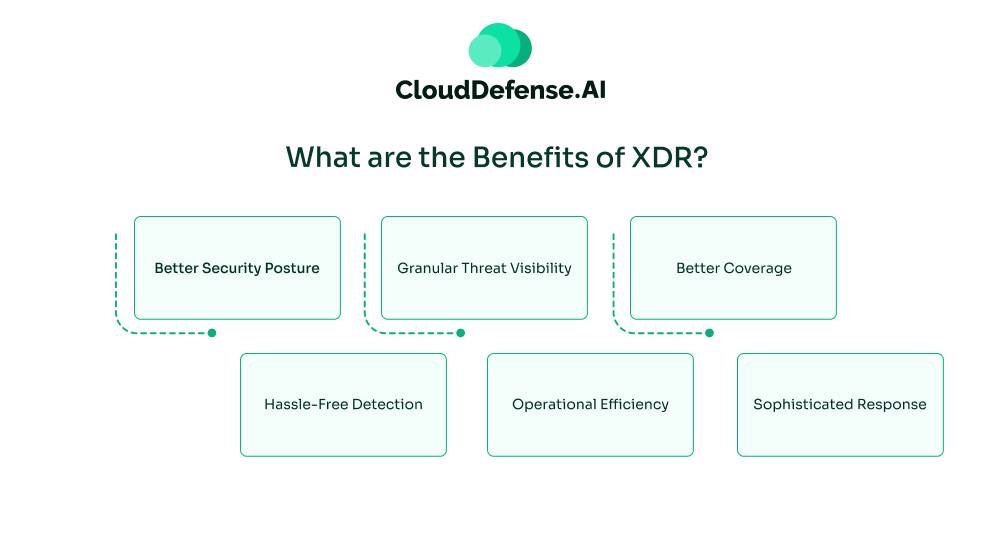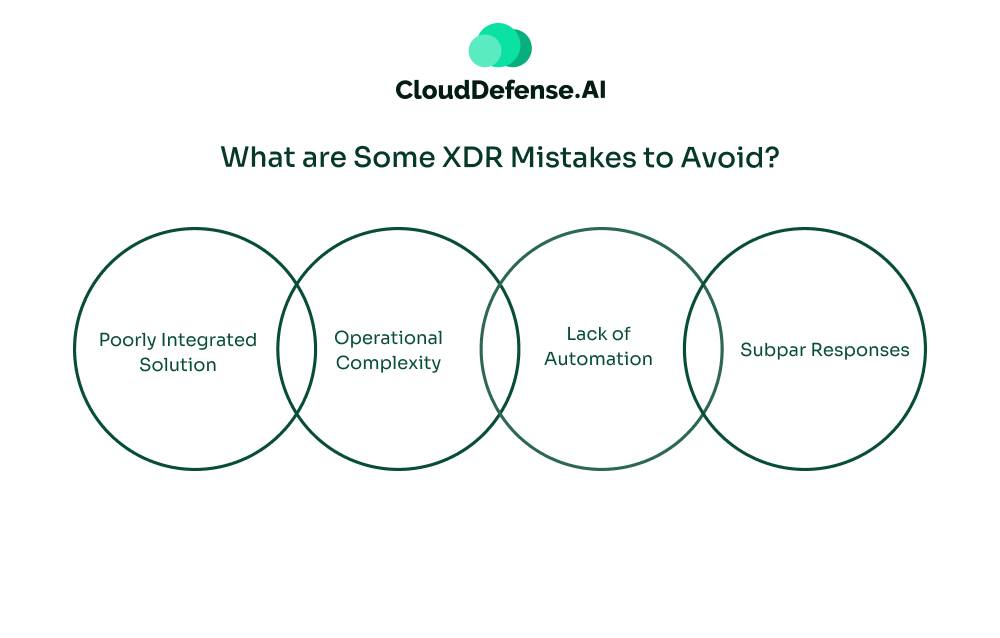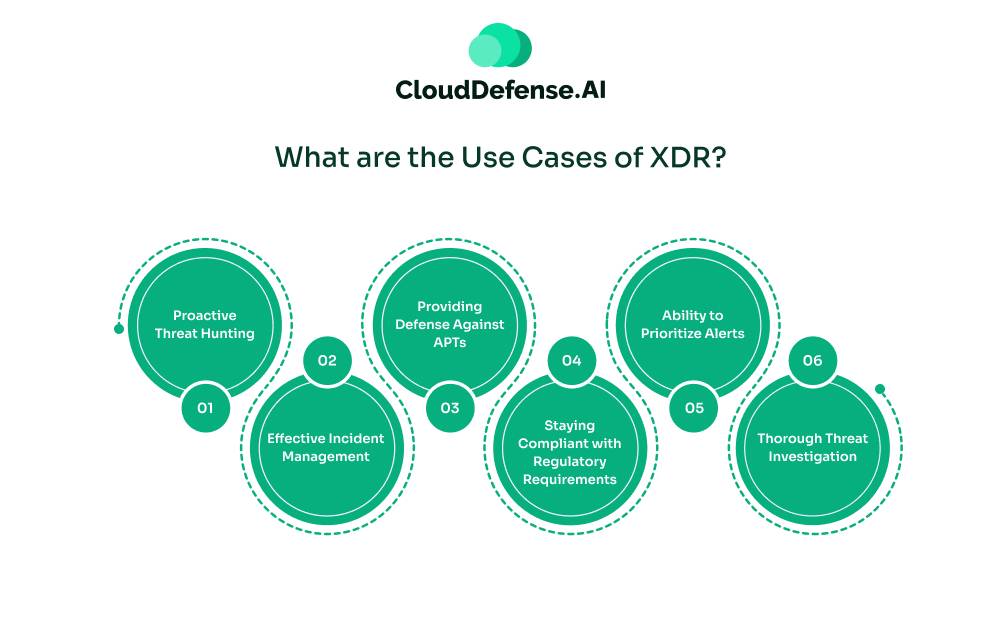Definition – What is Extended Detection and Response (XDR)?
Extended Detection and Response (XDR) is an advanced cybersecurity framework that unifies threat detection, investigation, and response across multiple security layers—network, endpoint, cloud, email, and identity systems. Unlike traditional security tools that work in silos, XDR consolidates data, correlates threats, and automates responses, delivering deeper visibility and faster remediation.
Breaking it Down:
- Extended → Goes beyond endpoints, integrating data from multiple security layers.
- Detection → Identifies advanced threats by correlating telemetry data.
- Response → Automates and streamlines mitigation, reducing dwell time.
Why XDR Matters?
Most security teams struggle with:
- Alert overload – Too many isolated alerts from different security tools.
- Lack of context – No single-pane view to analyze threats effectively.
- Slow response time – Manual investigations delay mitigation efforts.
XDR fixes this by:
- Integrating multiple security layers – No blind spots, full attack visibility.
- Correlating threat signals – Detects sophisticated, multi-stage attacks.
- Automating response actions – Reduces mean time to detect (MTTD) and respond (MTTR).
So, if your security team is drowning in alerts and missing critical threats, XDR is the evolution you need. It doesn’t just detect—it understands, correlates, and neutralizes cyber threats in real-time.
|
Want to dive deeper into how XDR compares to other security solutions? Check out our in-depth guide on EDR vs. XDR vs. MDR to understand the key differences and find the right fit for your security needs. Read now. |
Evolution of XDR
Before XDR, cybersecurity was a mess of disconnected tools, each trying to solve a piece of the puzzle but never seeing the full picture. Security teams were drowning in alerts, manually stitching together data from different platforms, and still missing critical threats.
The Pre-XDR Era
Here’s what most companies relied on before XDR came along:
- Antivirus (AV) – Good for catching basic malware but useless against modern, sophisticated attacks.
- Firewalls – Blocked unwanted traffic but couldn’t stop advanced threats moving inside the network.
- SIEM (Security Information and Event Management) – Collected logs from different tools but flooded teams with alerts, making real threats hard to spot.
- EDR (Endpoint Detection and Response) – EDR gave deep insights into endpoint threats but left out network, cloud, and identity security.
- NDR (Network Detection and Response) – NDR monitored network traffic for anomalies but didn’t cover endpoints or cloud-based threats.
Each tool did its own thing, with no real communication between them. This meant slow investigations, delayed responses, and blind spots big enough for attackers to slip through.
The Shift to EDR and MDR:
As cyber threats evolved, security needed an upgrade:
- EDR (Endpoint Detection and Response) – Finally, a tool that could detect and respond to threats at the endpoint level. But it still didn’t see beyond individual devices.
- MDR (Managed Detection and Response) – Outsourced security to experts who monitored and analyzed threats for companies that lacked in-house expertise. Helpful, but MDR still relied on separate tools.
Even with these improvements, the core problem remained, security teams were juggling too many systems that didn’t work together.
Why XDR Became Inevitable
Attackers weren’t just targeting one layer of security anymore. They were moving between endpoints, cloud, network, and identities, exploiting gaps between isolated tools.
Security teams needed a smarter, more connected approach:
- Unified threat detection across all security layers—no more silos.
- Automated response to stop attacks faster, with less manual effort.
- Better threat correlation to detect complex, multi-stage attacks in real-time.
That’s where XDR changed the game. It’s not just another security tool—it’s a fully integrated, intelligent defense system that actually sees and understands threats across your entire environment. No more guessing. No more chasing alerts. Just faster, smarter security.
How XDR Works?
XDR connects multiple security layers into a single, intelligent system and pieces everything together, showing the full attack story. Heres how it works:
1. Data Collection: Seeing Everything, Missing Nothing
XDR continuously gathers security data from:
- Endpoints (laptops, servers, mobile devices)
- Networks (firewalls, IDS/IPS, network traffic logs)
- Cloud environments (AWS, Azure, Google Cloud)
- Email and identity systems (Microsoft 365, Google Workspace, Active Directory)
Instead of looking at threats in isolation, XDR pulls everything into one place, ensuring no security event goes unnoticed.
2. Threat Correlation: Connecting the Dots
Most security tools bombard teams with alerts – XDR connects them. Using advanced analytics, AI, and behavioral analysis, XDR identifies:
- Patterns across multiple attack surfaces, such as a phishing email leading to endpoint malware
- Hidden, multi-stage attacks that traditional security tools might miss
- False positives vs. real threats, allowing teams to focus on what matters
For example, instead of separate alerts for a phishing email, an unauthorized login, and an endpoint malware infection, XDR correlates them into a single attack chain, showing exactly how an attack started and spread.
3. Automated and Guided Response: Stopping Attacks Faster
Once a threat is identified, XDR can:
- Automatically contain affected endpoints or isolate compromised user accounts
- Block malicious network traffic before it spreads
- Trigger guided response playbooks, helping security teams take the right action immediately
No more wasting hours sifting through alerts. XDR enables rapid response, reducing dwell time and minimizing damage.
4. Continuous Learning: Getting Smarter Over Time
XDR doesn’t just detect and respond—it learns. With each incident, it improves its threat detection, adapting to new attack techniques and strengthening security over time.
On the whole,
- Before XDR, security teams struggled to connect fragmented alerts, leading to slow response times and missed threats.
- With XDR, threats are correlated, prioritized, and neutralized automatically – reducing risk and improving security efficiency.
Key Components of XDR
A strong XDR solution isn’t just about detection—it’s about seamless integration, automated response, and continuous threat intelligence. Here are the core components that make XDR effective:
1. Cross-Layered Data Collection
XDR pulls security data from multiple sources to provide a unified threat view.
- Endpoints, networks, cloud, email, identity systems, and applications.
- Eliminates security silos and ensures better context for threat detection.
2. Advanced Threat Detection
XDR uses AI, machine learning, and behavioral analytics to detect threats faster.
- Identifies anomalies and sophisticated attack techniques beyond traditional signature-based detection.
- Correlates events across different security layers to reduce false positives.
3. Automated Response & Remediation
XDR doesn’t just detect threats—it acts on them in real-time.
- Auto-isolates infected endpoints, blocks malicious traffic, and kills processes.
- Reduces incident response time, preventing threats from spreading.
4. Threat Intelligence Integration
Feeds from global threat intelligence sources help XDR stay ahead of attackers.
- Continuously updates with new IOCs (Indicators of Compromise).
- Helps security teams identify attack patterns early.
5. Security Analytics & Correlation
XDR connects the dots between different attack signals to uncover hidden threats.
- Detects multi-stage attacks that would go unnoticed in isolated security tools.
- Provides deeper visibility across the entire IT environment.
6. Incident Investigation & Forensics
XDR enables quick root cause analysis to understand attacks.
- Offers detailed logs, attack timelines, and evidence tracking.
- Helps security teams improve defenses and prevent future incidents.
7. Seamless Integration with Security Tools
XDR works best when it integrates with existing security solutions.
- Connects with SIEM, SOAR, IAM, EDR, NDR, and firewalls.
- Creates a unified security ecosystem for better threat management.
Benefits of XDR

Instead of drowning in isolated alerts, security teams get a clear, unified view of threats across multiple environments. Here’s what makes XDR different.
1. Detects Threats Across Multiple Layers
Most security tools operate in silos—XDR breaks that barrier. It collects and analyzes security data from:
- Endpoints (laptops, mobile devices, servers)
- Networks (firewalls, intrusion detection systems)
- Cloud services (AWS, Azure, Google Cloud)
- Email and identity platforms (Microsoft 365, Google Workspace)
By pulling data from all these sources, XDR can spot attack patterns that traditional tools miss.
2. Smarter Threat Detection with AI and Behavioral Analysis
Security teams deal with an overwhelming number of alerts every day. XDR cuts through the noise by:
- Using AI and machine learning to identify real threats
- Correlating related events across different security layers
- Filtering out false positives and low-priority alerts
Instead of wasting time chasing meaningless alerts, teams focus on real security incidents.
3. Faster, Automated Response
When a security breach happens, every second counts. XDR speeds up response times by:
- Isolating compromised devices before the threat spreads
- Blocking malicious network traffic automatically
- Disabling compromised accounts to prevent unauthorized access
This reduces the damage of an attack and helps security teams act before things spiral out of control.
4. Full Attack Visibility and Forensics
XDR doesn’t just detect threats—it shows exactly how an attack happened. Security teams can see:
- Where the attack started (phishing email, infected endpoint, etc.)
- How it moved across the environment (lateral movement, privilege escalation)
- Which systems were impacted
This level of detail makes incident investigations faster and more accurate.
5. Always Learning and Adapting
Cyber threats evolve daily, and static security tools fall behind. XDR continuously improves by:
- Pulling in the latest threat intelligence
- Learning from previous attack patterns
- Adapting its detection techniques to catch new and emerging threats
This way, you can achieve
- Less manual work—security teams don’t have to stitch together data from multiple tools.
- Better threat detection—XDR sees the full picture, not just isolated alerts.
- Faster response—attacks are contained automatically, reducing potential damage.
What are Some XDR Mistakes to Avoid?

While XDR is a powerful cybersecurity solution, many organizations make mistakes when deploying and managing it. These missteps can weaken security effectiveness, cause operational inefficiencies, and even lead to a false sense of security. Here’s what to watch out for:
1. Treating XDR as Just Another Security Tool
XDR is not a standalone product—it’s a security strategy that integrates multiple security layers. A common mistake is deploying XDR like a traditional SIEM or EDR solution without leveraging its full capabilities.
- Don’t just use XDR for endpoint security—extend it across network, cloud, identity, and email security.
- Ensure proper data correlation from all security layers for better threat visibility.
- Use automated response actions to contain threats quickly instead of relying only on manual processes.
2. Ignoring Integration with Existing Security Stack
Many organizations deploy XDR but fail to integrate it with their existing security tools, creating blind spots.
- Ensure seamless integration with SIEM, SOAR, identity and access management (IAM), and firewall solutions.
- Avoid security silos—XDR should work as a centralized detection and response system.
- Validate whether your XDR solution supports third-party integrations before deployment.
3. Not Tuning XDR to Your Organization’s Needs
By default, XDR solutions come with generic threat detection rules, which may not be optimized for your environment.
- Customize detection rules based on your organization’s specific threats and risk profile.
- Regularly update and fine-tune detection policies to reduce false positives and avoid missing real threats.
- Train security teams to understand and interpret XDR alerts effectively to maximize efficiency.
4. Underestimating the Need for Skilled Security Analysts
XDR automates many processes, but it doesn’t eliminate the need for human expertise.
- Organizations often assume XDR will handle everything, leading to poor incident response.
- Security teams need proper training to analyze complex attack patterns and fine-tune the system.
- Combining automation with human decision-making ensures better threat detection and response.
5. Delaying Incident Response Actions
XDR provides real-time detection, but some teams delay responding due to alert fatigue or manual processes.
- Use automated containment for critical threats (e.g., isolating compromised endpoints).
- Set up clear escalation workflows so incidents are handled quickly.
- Regularly test incident response procedures to ensure teams act efficiently during real attacks.
6. Failing to Continuously Monitor and Adapt
Cyber threats evolve daily, and static security approaches don’t work.
- Regularly update threat intelligence feeds to detect emerging attack techniques.
- Continuously improve XDR detection rules based on new security incidents.
- Conduct routine security assessments to ensure XDR is performing at its best.
Why These Mistakes Matter
- A poorly implemented XDR solution won’t provide full security coverage.
- Ignoring integrations and customizations leads to blind spots in threat detection.
- Security teams must stay engaged—XDR is a tool, not a replacement for human expertise.
XDR is a powerful weapon against cyber threats, but only if implemented and managed correctly. Avoiding these common mistakes ensures maximum protection, efficiency, and return on investment.
XDR Mistakes to Avoid – Quick Reference Table
|
Mistake |
Impact |
Fix It By |
|
Using XDR as just another tool |
Limited threat detection |
Integrate across security layers |
|
Poor integration |
Blind spots in security |
Connect with SIEM, SOAR, IAM |
|
No customization |
False positives or missed threats |
Tune detection rules |
|
Relying only on automation |
Missed complex attacks |
Train security analysts |
|
Slow incident response |
Attack spreads before action |
Automate containment, set workflows |
|
No continuous updates |
Outdated detection, weak security |
Regularly update threat intel |
What are the Use Cases of XDR?

Extended detection and response or XDR has a variety of uses in the industry and it entirely depends upon the purpose of the organization. Here are some popular use cases of XDR:
Proactive Threat Hunting
Every organization has threats in their network but it is not always easy for security teams to perform threat hunting to identify them. Implementing XDR eases up most of the job because it offers a variety of threat data and automation capabilities.
It automates most of the proactive threat-hunting process and enables the team to prioritize their time on severe threats that require complete attention.
Effective Incident Management
Many organizations prefer to use XDR for its effective incident management as it can be configured to automatically or manually respond to threat incidents. It offers a variety of incident responses where it can block IP addresses, quarantine an infected device, quarantine email, kill an application, and many others.
Providing Defense Against APTs
XDR is widely implemented in organizations that require defense against Advanced Persistent Threats or APTs. XDR not only offers proactive threat detection but also offers a focused approach to threat response and prevention that is required to prevent APTs.
Since XDR offers centralized visibility and collects data across the environment, it helps the team to analyze patterns to identify indicators that might indicate APT’s presence. XDR also comes equipped with advanced threat detection and automated threat response that help security teams understand TTPs employed by APT actors and take effective mitigation steps.
Staying Compliant with Regulatory Requirements
When it comes to adhering to regulatory compliance, XDR is really useful for organizations. XDR helps organizations in various aspects like data protection, privacy monitoring, threat detection, risk management, incident response, audit trail recording, threat intelligence, and others that help in meeting regulatory requirements.
Whether an organization needs to comply with HIPAA, GDPR, PII, or FINRA, XDR plays an important role in helping the organization meet all the required requirements.
Ability to Prioritize Alerts
Every security team in an organization needs to prioritize alerts of threats and depending upon the severity they need to respond to the most impactful one.
However, prioritizing alerts while threat hunting often requires them to go through a lot of processes but XDR streamlines this task. Leveraging the deep analysis of a huge volume of data and correlating numerous alerts, helps the team to target high-priority alerts that need immediate response.
Thorough Threat Investigation
Enterprises from different sectors extensively use XDR because of its ability to uncover the origin of threats and assist in different threat investigations.
The collection of threat data from different sources, complete visibility, and automated analysis make it a powerful choice for threat investigation. It also helps the team understand the impact of a detected threat and what devices or users it might have affected.
Strategies for Effective XDR Implementation
Deploying XDR requires a strategic approach to maximize security benefits. Here’s how to implement XDR effectively:
1. Align XDR with Business and Security Goals
- Define clear objectives—are you focusing on threat detection, response automation, or compliance?
- Ensure XDR supports your industry’s specific security needs (e.g., finance, healthcare, cloud environments).
- Align XDR’s capabilities with existing security policies to avoid conflicts.
2. Integrate XDR Across All Security Layers
- Connect XDR with endpoints, networks, cloud, email, and identity security for full visibility.
- Ensure seamless integration with SIEM, SOAR, IAM, and other security tools.
- Break down security silos—XDR should unify and correlate all security data.
3. Fine-Tune Detection Rules and Policies
- Customize XDR’s detection rules to match your organization’s risk profile.
- Continuously update threat detection models to reduce false positives and improve accuracy.
- Regularly test and optimize automated response actions.
4. Leverage AI and Threat Intelligence
- Use AI-driven analytics to detect anomalies and sophisticated attack patterns.
- Incorporate real-time threat intelligence feeds to stay ahead of emerging threats.
- Automate threat correlation across multiple attack vectors.
5. Automate Response, But Keep Human Oversight
- Enable automated containment actions for high-priority threats (e.g., isolating infected endpoints).
- Define clear escalation workflows to ensure human analysts handle complex incidents.
- Maintain a balance between automation and expert-driven decision-making.
6. Train Security Teams for XDR Optimization
- Provide hands-on training for SOC teams, incident responders, and IT admins.
- Educate teams on how to interpret XDR alerts and fine-tune threat detection.
- Conduct regular incident response drills to test XDR effectiveness.
7. Continuously Monitor, Adapt, and Improve
- Regularly update XDR rules, policies, and integrations as cyber threats evolve.
- Perform routine security assessments to identify gaps in XDR coverage.
- Use post-incident analysis to refine detection and response strategies.
Bottom Line
Cyber threats aren’t slowing down, and neither should your security strategy. XDR isn’t just another tool, it’s a smarter way to detect, investigate, and stop attacks before they cause damage. But it’s not a magic fix. Success depends on proper setup, continuous tuning, and real-world expertise.
If you integrate it right, XDR can eliminate blind spots, reduce noise, and speed up response times. The question is – are you using it to its full potential?







